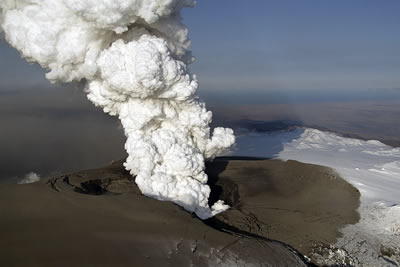Redoubt Volcano, Alaska (USA) during a continuous, low-level eruption of steam and ash on December 18, 1989.
Courtesy of USGS
Volcanic Ash
Ash is made of millions of tiny fragments of rock and glass formed during a volcanic eruption. Volcanic ash particles are less than 2 mm in size and can be much smaller.
Volcanic ash forms in several ways during eruptions. Sometimes gas is released from the underground magma chamber which shatters rock into the tiny pieces that make up ash. Sometimes, newly-formed volcanic rock shatters into ash when it comes into contact with water or ice and cools quickly.
Falling ash can sometimes cause more damage than flowing lava because ash can be carried great distances through the atmosphere. Volcanoes have a cooling effect on weather because the ash remains in the sky and reduces the amount of sunlight reaching the surface. Ash however, also carries important nutrients to the soil on which it finally lands.
Last modified April 19, 2010 by Lisa Gardiner.
You might also be interested in:

Cinder cones are simple volcanoes which have a bowl-shaped crater at the summit and only grow to about a thousand feet, the size of a hill. They usually are created of eruptions from a single opening,
...more
Mount St. Helens, a volcano in Washington on the west coast of the United States, has been quiet for 18 years but now it is quiet no more! It has been puffing steam and ash as scientists look for clues
...more
Some of the factors that have an affect on climate, like volcanic eruptions and changes in the amount of solar energy, are natural. Others, like the addition of greenhouse gases to the atmosphere, are
...more
Scientists are using information they have from past volcanic eruptions to better understand strong volcanic plumes. They have observed that in some volcanic eruptions, there is a spontaneous formation
...more
In the spring of 2010, the eruption of a volcano called Eyjafjallajökull in Iceland cancelled many flights in Europe. Eyjafjallajökull is a glaciovolcano, which means it's a volcano that is covered by
...more
Ash is made of millions of tiny fragments of rock and glass formed during a volcanic eruption. Volcanic ash particles are less than 2 mm in size and can be much smaller. Volcanic ash forms in several ways
...more
Lava can move in broad flat lava flows, or it can move through tight channels or tubes. Lava flows tend to cool quickly and flow slowly. The fastest lava outside of channels moves at about 6 mi/hr an easy
...more














